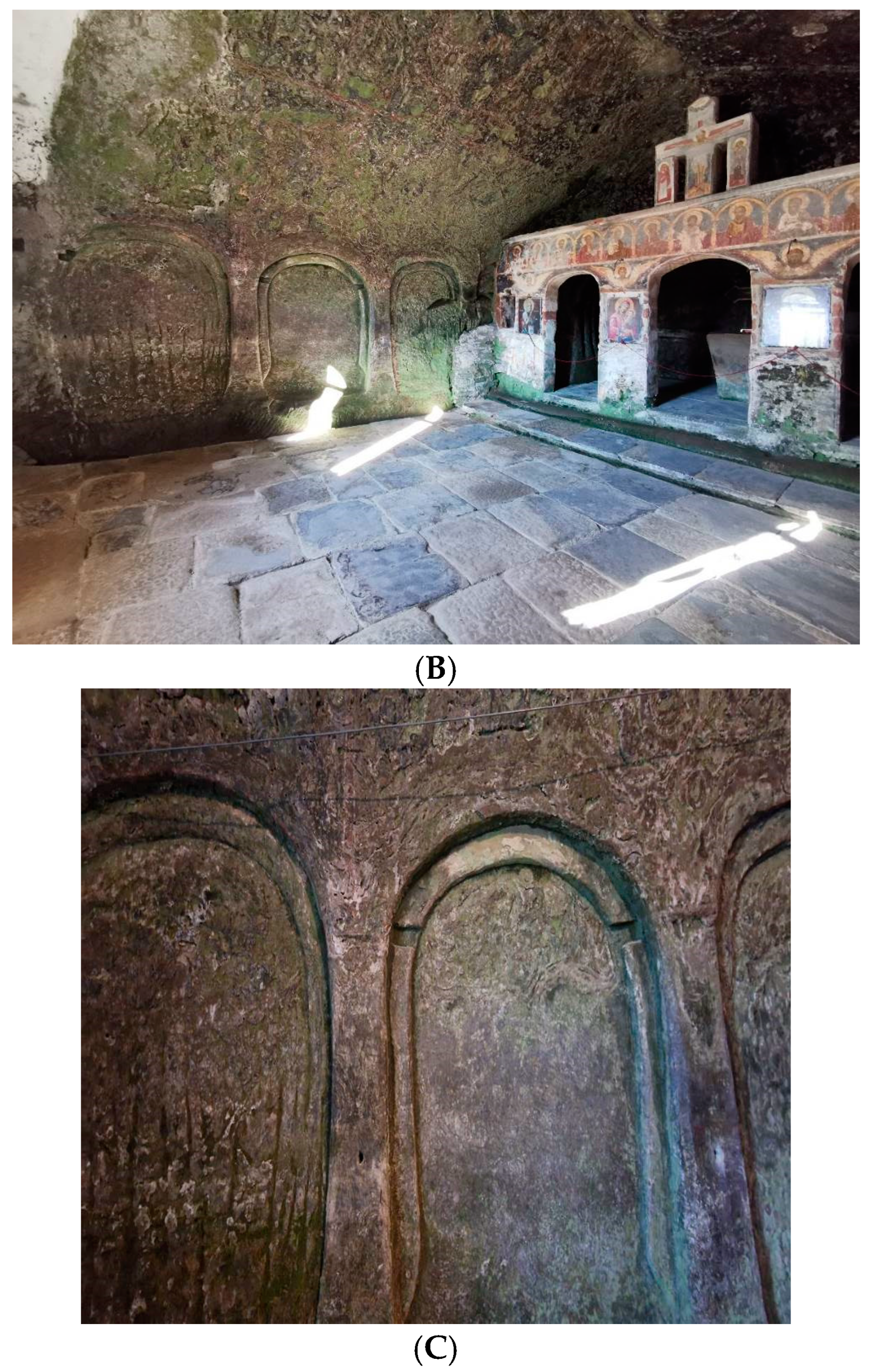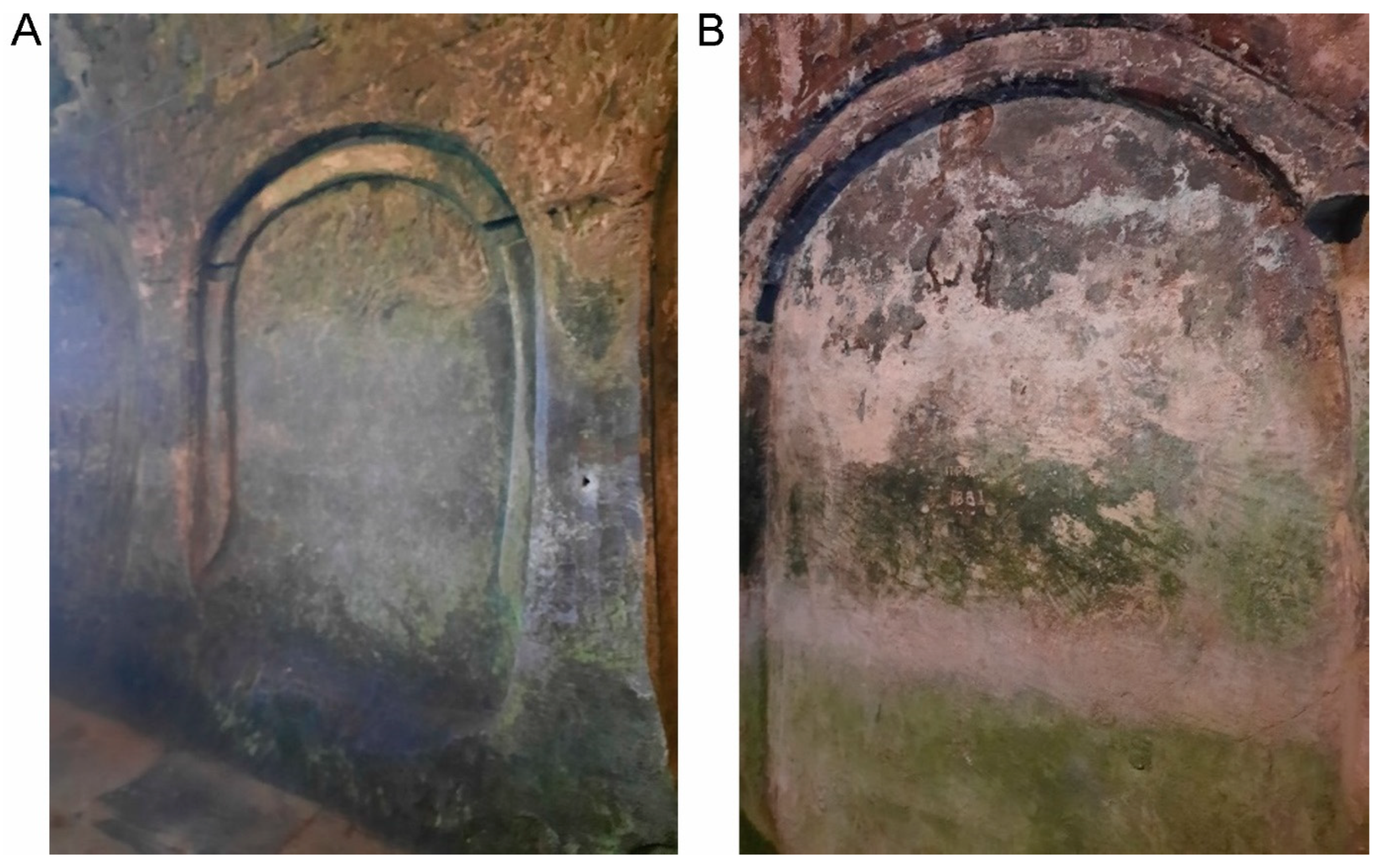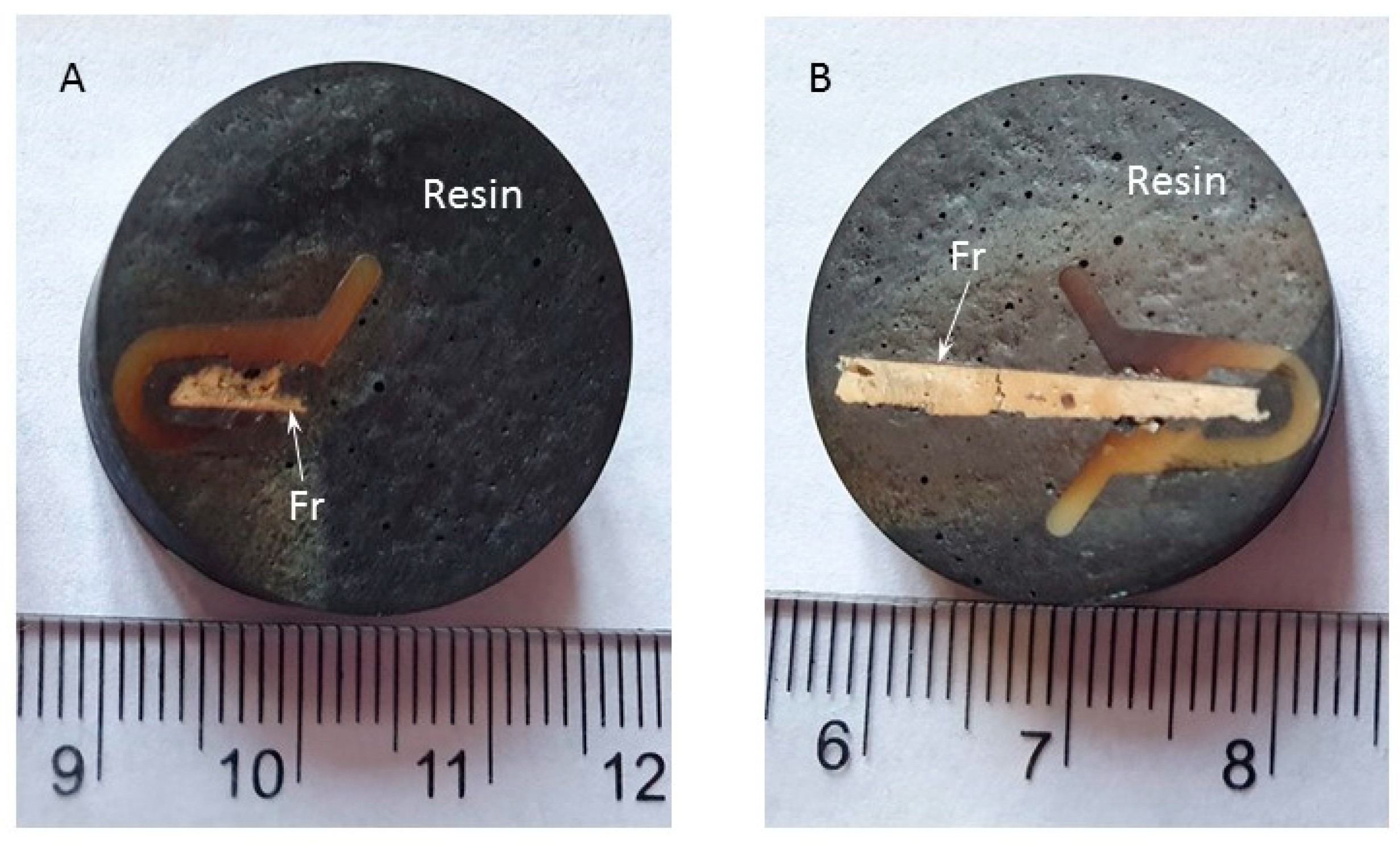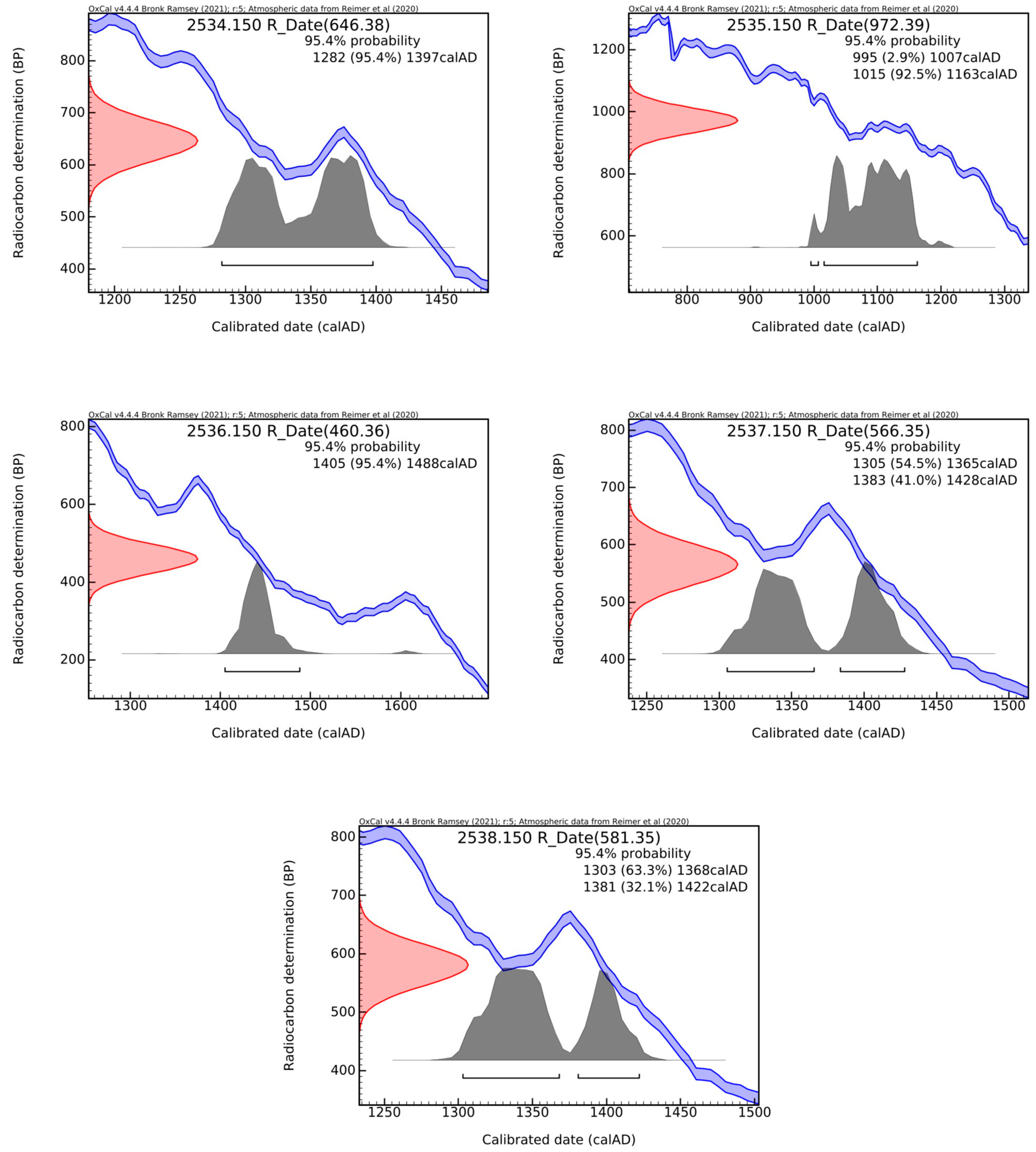Radiocarbon Dating of Mortar Fragments from the Fresco of a Romanian Monastery: A Field Study
Abstract
:1. Historic
2. Geological, Mineralogical and Hydrogeological Considerations
3. Preliminary Dating Characteristics and Radiocarbon Dating
Materials and Characterization Techniques
4. Experimental Results
- Identified pigments: lead minium, Pb3O4, applied with the initial addition of an organic binder or during previous interventions (red pigment); white lime; cinnabar (HgS); lead carbonate, PbCO3 as a result of degradation or impurity from the lead mine; red and yellow based on iron oxides and coal black;
- Bluish hue: possible mixing of lime white with coal black;
- Possibly azure or malachite in some paintings; possibly an introduction from the time of painting the pediment, like lead white;
- Scheele green pigment CuHAsO3 and Schweinfurt green pigment Cu(CH3COO)2Cu(AsO2)2, used from the 18th–19th century until the beginning of the 20th century;
- Sulfates and nitrates as salts formed by degradation;
- Alteration products: calcium oxalate; lead carbonate from the alteration of lead minium;
- Analyzes by pigment classes are extensively commented;
- Natural and artificial pigments were used;
- Natural pigments used for ocher and red colors: hematite, limonite, cinnabar;
- Artificial pigments used in white, black, gray and partially red colors;
- Some ingredients are native: limestone, coal, hematite, limonite;
- Cinnabar is “imported”.
5. Determination of the Chronology
6. Conclusions
Author Contributions
Funding
Institutional Review Board Statement
Informed Consent Statement
Data Availability Statement
Acknowledgments
Conflicts of Interest
References
- Ilinescu, I.; Gorunescu, I.; Şerban, I.-A. Monastery of Corbii de Piatrǎ; History Files; S.C. Zodia Gemenilor S.R.L.: Arges, Romania, 2009. [Google Scholar]
- Available online: https://viavalahia.ro/en/corbi-arges-county (accessed on 29 September 2023).
- Available online: https://ro.wikipedia.org/wiki/Mǎnǎstirea_Corbii_de_Piatrǎ (accessed on 29 September 2023).
- Available online: https://revistaagressive.ro/cultura/capadocia-de-la-arges (accessed on 29 September 2023).
- Dumitrescu, C.L. Corbii de Piatră Rock Church, the Oldest Group of Paintings—Known Today—From Romania; Art History Studies and Research; Romanian Academy Publishing House: Bucharest, Romania, 1975; Volume 22. [Google Scholar]
- Vâlcea, A.E.; Grecu, D.; Maris, I.; Negrea, A.D.; Cimpoesu, N.; Giugea, D.; Istrate, B.; Munteanu, C.; Moga, S.G.; Anghel, D.-C.; et al. The Characterization of a Fragment of a Medieval Fresco from Corbii de Piatră Cave Church. Appl. Sci. 2023, 13, 4933. [Google Scholar] [CrossRef]
- Vâlcea, A.E.; Maris, I.; Negrea, A.D.; Cimpoesu, N.; Garbea, G.; Grecu, D.; Moga, S.G.; Istrate, B.; Finta, F.N.; Rizea, A.D.; et al. Interdisciplinary Research on Medieval Fresco Subjected to Degradation Processes in the Corbii de Piatra Cave Church. Materials 2023, 16, 5257. [Google Scholar] [CrossRef]
- Barzoi, S.C.; Luca, A.C. Significance of studying the petrography and mineralogy of the geological environment of old rupestrian churches to prevent their deterioration.A case study from the South Carpathians. J. Cult. Herit. 2013, 14, 163–168. [Google Scholar] [CrossRef]
- Corbii de Piatrǎ. Interdisciplinary Study; Section 2 “Geological characterization of the site”; Şeclǎman, M., Bǎrzoi, S.C., Luca, A., Roban, R., Eds.; National University of Arts Printing: Bucharest, Romania, 2010. [Google Scholar]
- Corbii de Piatrǎ. Interdisciplinary Study; Section 4 “Technological study of the constituent materials of the mural painting”: Mohanu, I., Chatzitheodoridis, E., Barbu, O.-H., Niculescu, G., Georgescu, M., Şeclǎman, M., Bǎrzoi, S.C., Luca, A., Roban, R.; Section 5 “Technological milestones regarding the execution of the mural paintings from Corbii de Piatrǎ”: Mohanu, D.; Section 6 “Causes and specific forms of degradation”: Mohanu, D., Şeclǎman, M., Bǎrzoi, S.C., Luca, A., Roban, R.; Section 7 “Biodeterioration and biodeteriogens”: Gomoiu, I., Chatzitheodoridis, E.; National University of Arts Printing: Bucharest, Romania, 2010. [Google Scholar]
- Mohanu, D.; Cincheza-Buculei, E.; Seclaman, M.; Luca, A.; Barzoi, S.C.; Roban, R.-D.; Onete, M.; Gomoiu, I.; Chatzitheodoridis, E.; Niculescu, G.; et al. Interdisciplinary Study. Available online: https://www.researchgate.net/publication/280919986_Corbii_de_Piatra_Studiu_interdisciplinary_Corbii_de_Piatra_Interdisciplinary_study (accessed on 26 January 2024).
- Marincas, O. Contribution of the George Enescu Iasi University of Arts to the Interdisciplinary Research Project of Historical Monuments in Romania Undergoing Restoration. Available online: http://www.revistamonumenteloristorice.ro/fisiere/RMI_2008_1-2-010.pdf (accessed on 13 October 2021).
- National University of Arts. Integrated Research Strategy of the State of Conservation of Some Cave Churches in Order to Restore and Enhance Them—Case Study, 3rd ed.; Corbii de Piatrǎ: Bucharest, Romania, 2008; pp. 8–11. [Google Scholar]
- Ghiran, M.D.; Popa, M.E.; Mariș, I.; Predeanu, G.; Gheorghe, S.; Bălănescu, N.M. Thermal Maturity and Kerogen Type of Badenian Dispersed Organic Matter from the Getic Depression, Romania. Minerals 2023, 13, 202. [Google Scholar] [CrossRef]
- Săndulescu, M. Geotectonics of Romania; Technical Publishing House: Bucharest, Romania, 1984; p. 335. (In Romanian) [Google Scholar]
- Murgeanu, G.; Mihăilă, N.; Stancu, J.; Dessila-Codarcea, M.; Bombiță, G.; Lupu, M. Harta geologică a României, 1:200 000, Foaia Pitești; Comitetul de Stat al Geologiei, Institutul Geologic: Bucharest, Romania, 1967. (In Romanian) [Google Scholar]
- El-Taher, A. Assessment of natural radioactivity levels and radiation hazards for building materials used in Qassim area, Saudi Arabia. Rom. J. Phys. 2012, 57, 726–735. [Google Scholar]
- Özen, S.A.; Celik, N.; Dursun, E.; Taskin, H. Indoor and outdoor radon measurements at lung cancer patients’ homes in the dwellings of Rize Province in Turkey. Environ. Geochem. Health 2018, 40, 1111–1125. [Google Scholar] [CrossRef]
- Calin, M.R.; Ion, A.C.; Radulescu, I.; Simion, C.A.; Mincu, M.M.; Ion, I. Analysis of the radon concentrations in natural mineral and tap water using lucas cells technique. J. Environ. Eng. Landsc. Manag. 2022, 30, 370–379. [Google Scholar] [CrossRef]
- Muntean, L.E.; Manea, D.L.; Cosma, C. The radioactivity levels in various plastering mortars made with river aggregates from the Alba County. Rom. J. Mater. 2012, 42, 30–36. [Google Scholar]
- McMillen, M. Radon: How It Can Affect Your Health. WebMD, 7 August 2024. Available online: https://www.webmd.com/lung-cancer/radon-health-effects (accessed on 19 December 2024).
- Simion, C.A.; Stanciu, I.M.; Sava, T.B.; Pacesila, D.G. Radiocarbon dating of a sample of hydraulic mortar from Porolissum customs, Revista Română de Materiale. Rom. J. Mater. 2022, 52, 349–356. [Google Scholar]
- Marcu Istrate, D.; Stanciu, I.M.; Simion, C.A.; Sava, T.B.; Pacesila, D.G.; Ionita, A.; Dobrota, S.O. Feldioara/Marienburg Fortress, in Transylvania, Romania. Traditional Dating and Radiocarbon Dating of Mortar: An archaeometric perspective. Archaeometry, 2025; manuscript in preparation. [Google Scholar]
- Simion, C.; Stanciu, I.; Gaza, O.; Sava, T.; Pacesila, D.; Ilie, M.; Manailescu, C.; Robu, A. Radiocarbon dating of mortar based on hydraulic lime. Advantages, disadvantages, limitations. AIP Conf. Proc. 2019, 2076, 050003. [Google Scholar] [CrossRef]
- Romania Laws—UNESCO World Heritage Convention. 2019. Available online: https://fr.unesco.org (accessed on 15 September 2021).
- Romania 3.1—Compendium of Cultural Policies & Trends. Available online: https://www.culturalpolicies.net (accessed on 15 September 2021).
- Calandra, S.; Barone, S.; Cantisani, E.; Caggia, M.P.; Liccioli, L.; Vettori, S.; Fedi, M. Radiocarbon dating of straw fragments in the plasters of St. Philip church in archaeological site Hierapolis of Phrygia (Denizli, Turkey). Radiocarbon 2023, 65, 323–334. [Google Scholar] [CrossRef]
- LAMOA Expertise. Available online: https://www.lamoa.fr (accessed on 20 October 2022).
- Characterization and Microanalysis of Ancient and Modern Materials by Physico-Chemical Methods. Available online: https://www.archeophile.com/rwcat_129-laboratoires.htm (accessed on 20 October 2022).
- Hagni, R.D.; Karakus, M. Cathodoluminescence Microscopy: A Valuable Technique for Studying Ceramic Materials. MRS Bull. 1989, 14, 54–59. [Google Scholar] [CrossRef]
- Marshall, D. Cathodoluminiscence of Geological Materials, 1st ed.; Springer: London, UK, 1988. [Google Scholar]
- Pokrovsky, O.S.; Golubev, S.V.; Schott, J. Calcite, dolomite and magnesite dissolution kinetics in aqueous solutions at acid to neutral pH, 25 to 150 °C and 1 to 55 atm pCO2: New constraints on CO2 sequestration in sedimentary basins. Chem. Geol. 2009, 265, 20–32. [Google Scholar] [CrossRef]
- Coacă, E.; Rusu, O.A.; Marin, A.H.; Velciu, L.; Mihalache, M.; Andrei, V.A.; Vişan, T. Microscopic and Electrochemical Characterization of Alumina Ceramic Films Developed onto 316l Stainless Steel by Microarc Oxidation in Plasma Electrolysis. U.P.B. Sci. Bull. Ser. B 2018, 80, 17–32. [Google Scholar]
- Martinetto, P.; Rousselière, H.; Walter, P. Identifier les pigments et comprendre leurs properties à partir de la diffraction des rayons X. L’Actualité Chimique juil-août-sept-oct 2014, 387–389, 170–174. [Google Scholar]
- LAMOA: Étude des Peintures Murales Avant la Restauration. Available online: https://www.lamoa.fr/services_analyse_des_peintures_murales.html (accessed on 15 October 2022).
- Dupouy, J.-M. Les rayons X et l’étude des œuvres d’art. J. Phys. IV 1996, 6, C4-791–C4-808. [Google Scholar] [CrossRef]
- Sardos, N.; Velarde, N.; Del, S.; Chapoulie, R.; Castillo Butters, L.J. Caractérisation physico-chimique des pigments des peintures murales mochica: San José de Moro (VIII ème—X ème siècles apr. J.-C.). J. Soc. Am. 2017, 103, 217–235. [Google Scholar] [CrossRef]
- Wacker, L.; Němec, M.; Bourquin, J. A revolutionary graphitization system: Fully automated, compact and simple. Nucl. Instrum. Methods Phys. Res. B 2010, 268, 931–934. [Google Scholar] [CrossRef]
- Wacker, L.; Christl, M.; Synal, H.-A. BATS: A new tool for AMS data reduction. Nucl. Instrum. Methods Phys. Res. B 2010, 268, 976–979. [Google Scholar] [CrossRef]
- Stuiver, M.; Polach, H. Discussion: Reporting of 14C data. Radiocarbon 1977, 19, 355–363. [Google Scholar] [CrossRef]
- Vitruvius, The Ten Books on Architecture; Translated by Morgan, M.H., with Illustrations and Original Designs Prepared Under the Direction of Warren, H.L., and Robinson, N., Jr.; Harvard University Press London: London, UK; Humphrey Milford Oxford University Press: Cambridge, UK, 1914; Available online: https://en.wikisource.org/wiki/Ten_Books_on_Architecture (accessed on 16 March 2021).
- Stamboliyska, B.; Tapanov, S.; Kovacheva, D.; Atanasova-Vladimirova, S.; Ranguelov, B.; Yancheva, D.; Velcheva, E.; Stoyanov, S.; Guncheva, M.; Fischer, D.; et al. Characterization of art materials and degradation processes in the exterior wall paintings of the main church of Rila Monastery, Bulgaria. Vib. Spectrosc. 2023, 128, 103580. [Google Scholar] [CrossRef]
- Pelosi, C.; Agresti, G.; Andaloro, M.; Baraldi, P.; Pogliani, P.; Santamaria, U. The Rock Hewn Wall Paintings in Cappadocia (Turkey). Characterization of the Constituent Materials and a Chronological Overview. U.S. Pharmacopeia. Available online: https://www.researchgate.net/publication/257365941 (accessed on 26 January 2025).
- Ghita, D.G.; Moşu, D.V.; Dogaru, M.; Gugiu, M.M.; Popescu, I.V.; Dobrescu, S.; Călinescu, C.I.; Căta-Danil, G.; Enăchescu, M.; Mărginean, N.; et al. Improvements of the research infrastructure at the tandem laboratory in IFIN-HH. AIP Conf. Proc. 2013, 1525, 208. [Google Scholar] [CrossRef]
- Stan-Sion, C.; Enachescu, M.; Petre, A.R.; Simion, C.A.; Calinescu, C.I.; Ghita, D.G. A new and compact system at the AMS laboratory in Bucharest. Nucl. Instrum. Methods Phys. Res. Sect. B—Beam Interact. Mater. At. 2015, 361, 105–109. [Google Scholar] [CrossRef]
- Sava, T.B.; Simion, C.A.; Gâza, O.; Stanciu, I.M.; Pacesilă, D.G.; Sava, G.O.; Wacker, L.; Ștefan, B.; Moșu, V.D.; Ghita, D.G.; et al. Status Report on the Sample Preparation Laboratory for Radiocarbon Dating at the New Bucharest Roams Center. Radiocarbon 2019, 61, 649–658. [Google Scholar] [CrossRef]
- Ramsey, C.B. Radiocarbon calibration and analysis of stratigraphy: The OxCal program. Radiocarbon 1995, 37, 425–430. [Google Scholar] [CrossRef]
- Reimer, P.J.; Austin, W.E.N.; Bard, E.; Bayliss, A.; Blackwel, P.G.; Bronk Ramsey, C.; Butzin, M.; Cheng, H.; Edwards, R.L.; Friedrich, M.; et al. The IntCal20 Northern Hemisphere Radiocarbon Age Calibration Curve (0–55 cal kBP). Radiocarbon 2020, 62, 725–757. [Google Scholar] [CrossRef]
- Ştefǎnescu, I.D. La peinture réligieuse en Valachie et Transylvanie (Addenda); P. Geuthner: Paris, France, 1932; pp. 421–424. [Google Scholar]
- Ştefǎnescu, I.D. Iconography of Byzantine Art and Romanian Feudal Painting; Editura Meridiane: Bucharest, Romania, 1973; p. 187. [Google Scholar]
- Thierry, N. Destruction of the sites and mural paintings of Cappadocia: Natural and human causes. In Proceedings of the European Symposium: Science, Technology and European Cultural Heritage, Bologna, Italy, 13–16 June 1989; pp. 505–510. [Google Scholar]
- Balcázar, M.; Gómez, S.; Peña, P.; Zavala Arredondo, J.; Gazzola, J.; Villamares, A. Presence of a radioactive gas in archaeological excavations, determination and mitigation. Appl. Radiat. Isot. 2014, 83, 272–275. [Google Scholar] [CrossRef] [PubMed]
- Quirós Castillo, J.A. The radiocarbon dates of historical period sites. Problems and experiences of analysis in medieval contexts, Munibe. Anthropol. Archaeol. 2009, 60, 313–324. [Google Scholar]
- Sbroscia, M.; Pelosi, C.; Agresti, G.; Paolucci, A.; Pogliani, P.; Ruggiero, L.; Sodo, A. Spectroscopic investigation of Cappadocia proto-Byzantine paintings. J. Raman Spectrosc. 2021, 52, 95–108. [Google Scholar] [CrossRef]
- Philippova, O.S.; Dmitriev, A.Y.; Tsarevskaya, T.J.; Makarova, A.M.; Grebenshchikova, A.B. Medieval mural painting: A look through the centuries. J. Cult. Herit. 2023, 62, 460–469. [Google Scholar] [CrossRef]
- Shevchenko, D.; Sadovskaya, Y.; Shkondin, V.; Zhurbin, Y.; Ostrovsky, A. Rock-Cut Church Göreme 31 (Cappadocia, Turkey): New Data from the Study in Situ (2014–2015). Scrinium 2021, 17, 274–290. [Google Scholar] [CrossRef]
- Available online: https://uchisarcappadocia.org/red-church/ (accessed on 3 February 2025).
- Krajcar Bronić, I.; Topić, N.; Radić, I.; Peković, Ž.; Sironić, A. Radiocarbon dating of St. Stephen’s in Pustijerna church in Dubrovnik, Croatia. In Proceedings of the Balkan Archaeometry Symposium, Bucharest, Romania, 29–30 September 2012. [Google Scholar] [CrossRef]













| Sample Name | Weight [mg] |
|---|---|
| S1 | 265.7 |
| S2 | 243.5 |
| N1 | 39.1 |
| N2 | 196.5 |
| N3 | 351.0 |
| Sample Name | Mg | Al | Si | P | S | K | Ca | Ti | V | Cr | Mn |
|---|---|---|---|---|---|---|---|---|---|---|---|
| S2 | 5474 | 0 | 165,353 | 0 | 2308 | 0 | 183,631 | 135 | 0 | 69 | 197 |
| S1 | 7543 | 1055 | 133,947 | 2060 | 55,834 | 0 | 162,457 | 352 | 33 | 36 | 383 |
| N3 | 7138 | 7578 | 277,789 | 616 | 1082 | 1082 | 128,797 | 1596 | 0 | 92 | 257 |
| N2 | 3863 | 6968 | 203,358 | 0 | 2654 | 1406 | 38,027 | 907 | 33 | 15 | 182 |
| N1 | 6255 | 0 | 137,900 | 494 | 2725 | 0 | 77,282 | 122 | 0 | 0 | 136 |
| S2 | Fe | Ni | Cu | Zn | As | Sr | Y | Mo | Pb | Th | U |
| S1 | 9720 | 111 | 33 | 104 | 84 | 197 | 14 | 0 | 19 | 0 | 0 |
| N3 | 24,554 | 128 | 0 | 561 | 3946 | 322 | 74 | 11 | 1421 | 19 | 176 |
| N2 | 17,850 | 43 | 33 | 38 | 0 | 101 | 0 | 0 | 0 | 0 | 0 |
| N1 | 12,689 | 127 | 40 | 56 | 0 | 113 | 0 | 0 | 0 | 0 | 0 |
| S2 | 2498 | 182 | 77 | 75 | 0 | 127 | 0 | 0 | 0 | 0 | 0 |
| Sample Name | Mg | Err | Al | Err | Si | Err | P | Err | S | Err | K | Err | Ca | Err | Ti | Err | V | Err | Cr | Err | Mn | Err |
|---|---|---|---|---|---|---|---|---|---|---|---|---|---|---|---|---|---|---|---|---|---|---|
| S2 | 5474 | 3077 | 0 | 165,353 | 1170 | 0 | 2308 | 131 | 0 | 183,631 | 325 | 135 | 22 | 0 | 69 | 10 | 197 | 12 | ||||
| S1 | 7543 | 3299 | 1055 | 618 | 133,947 | 1085 | 2060 | 191 | 55,834 | 346 | 0 | 162,457 | 318 | 352 | 26 | 33 | 14 | 36 | 11 | 383 | 16 | |
| N3 | 7138 | 2955 | 7578 | 674 | 277,789 | 1472 | 616 | 179 | 1082 | 110 | 1082 | 92 | 128,797 | 279 | 1596 | 36 | 0 | 92 | 11 | 257 | 15 | |
| N2 | 3863 | 1945 | 6968 | 567 | 203,358 | 1163 | 0 | 2654 | 90 | 1406 | 59 | 38,027 | 137 | 907 | 24 | 33 | 12 | 15 | 8 | 182 | 10 | |
| N1 | 6255 | 2106 | 0 | 137,900 | 968 | 494 | 120 | 2725 | 96 | 0 | 77,282 | 192 | 122 | 16 | 0 | 0 | 136 | 10 |
| Sample Name | Fe | Err | Ni | Err | Cu | Err | Zn | Err | As | Err | Sr | Err | Y | Err | Mo | Err | Pb | Err | Th | Err | U | Err |
|---|---|---|---|---|---|---|---|---|---|---|---|---|---|---|---|---|---|---|---|---|---|---|
| S2 | 9720 | 61 | 111 | 22 | 33 | 22 | 104 | 14 | 84 | 15 | 197 | 10 | 14 | 8 | 19 | 6 | ||||||
| S1 | 24,554 | 109 | 128 | 23 | 561 | 26 | 3946 | 64 | 322 | 12 | 74 | 10 | 11 | 5 | 1421 | 21 | 19 | 2 | 176 | 16 | ||
| N3 | 17,850 | 76 | 43 | 16 | 33 | 15 | 38 | 9 | 101 | 7 | ||||||||||||
| N2 | 12,689 | 59 | 127 | 22 | 40 | 19 | 56 | 11 | 113 | 8 | ||||||||||||
| N1 | 2498 | 30 | 182 | 28 | 77 | 26 | 75 | 14 | 127 | 11 |
| Sample Name | TC [%] | IC [%] | TOC [%] |
|---|---|---|---|
| S1 | 8.88 ± 0.44 | 8.56 ± 0.43 | 0.32 ± 0.01 |
| S2 | 8.99 ± 0.45 | 8.45 ± 0.42 | 0.54 ± 0.03 |
| N2 | 9.86 ± 0.49 | 9.86 ± 0.49 | Near 0 |
| N3 | 10.09 ± 0.50 | 9.55 ± 0.48 | 0.54 ± 0.03 |
| No | Weight [mg] | Sample Name | Lab Code (RoAMS) | N Area | C Area | N [%] | C [%] | C/N Ratio |
|---|---|---|---|---|---|---|---|---|
| 1 | 34.31 | S1 | G4896_2534.150 | 8657 | 92113 | 0.67 | 10.13 | 15.01 |
| 2 | 16.92 | S2 | G4897_2535.150 | 8238 | 45221 | 1.30 | 10.08 | 7.76 |
| 3 | 19.09 | N2 | G4898_2537.150 | 825 | 52457 | 0.12 | 10.36 | 88.95 |
| 4 | 19.28 | N3 | G4899_2538.150 | 894 | 57986 | 0.13 | 11.35 | 89.81 |
| 5 | 17.21 | N1 | G4900_2536.150 | 1242 | 44391 | 0.27 | 9.73 | 49.09 |
Disclaimer/Publisher’s Note: The statements, opinions and data contained in all publications are solely those of the individual author(s) and contributor(s) and not of MDPI and/or the editor(s). MDPI and/or the editor(s) disclaim responsibility for any injury to people or property resulting from any ideas, methods, instructions or products referred to in the content. |
© 2025 by the authors. Licensee MDPI, Basel, Switzerland. This article is an open access article distributed under the terms and conditions of the Creative Commons Attribution (CC BY) license (https://creativecommons.org/licenses/by/4.0/).
Share and Cite
Abrudeanu, M.; Simion, C.A.; Valcea, A.E.; Ilie, M.V.; Ispas, E.A.; Marin, M.L.; Mirea, D.A.; Olteanu, D.C.; Manailescu, C.; Petre, A.R.; et al. Radiocarbon Dating of Mortar Fragments from the Fresco of a Romanian Monastery: A Field Study. Materials 2025, 18, 1149. https://doi.org/10.3390/ma18051149
Abrudeanu M, Simion CA, Valcea AE, Ilie MV, Ispas EA, Marin ML, Mirea DA, Olteanu DC, Manailescu C, Petre AR, et al. Radiocarbon Dating of Mortar Fragments from the Fresco of a Romanian Monastery: A Field Study. Materials. 2025; 18(5):1149. https://doi.org/10.3390/ma18051149
Chicago/Turabian StyleAbrudeanu, Marioara, Corina Anca Simion, Adriana Elena Valcea, Maria Valentina Ilie, Elena Alexandra Ispas, Maria Loredana Marin, Dragos Alexandru Mirea, Dan Cristian Olteanu, Cristian Manailescu, Alexandru Razvan Petre, and et al. 2025. "Radiocarbon Dating of Mortar Fragments from the Fresco of a Romanian Monastery: A Field Study" Materials 18, no. 5: 1149. https://doi.org/10.3390/ma18051149
APA StyleAbrudeanu, M., Simion, C. A., Valcea, A. E., Ilie, M. V., Ispas, E. A., Marin, M. L., Mirea, D. A., Olteanu, D. C., Manailescu, C., Petre, A. R., Negrea, D. A., Moga, S. G., Maris, I., Grecu, D., Garbea, G., Finta, F. N., & Petrescu, M. I. (2025). Radiocarbon Dating of Mortar Fragments from the Fresco of a Romanian Monastery: A Field Study. Materials, 18(5), 1149. https://doi.org/10.3390/ma18051149








